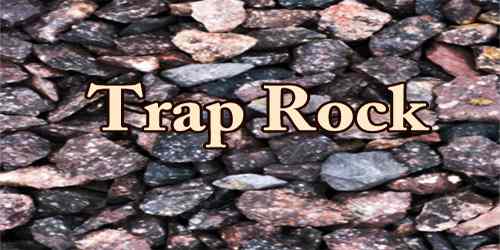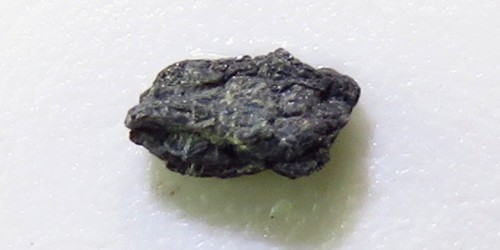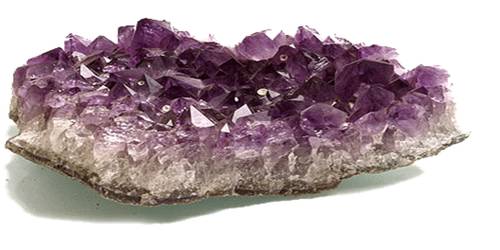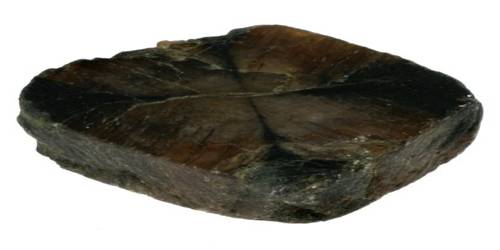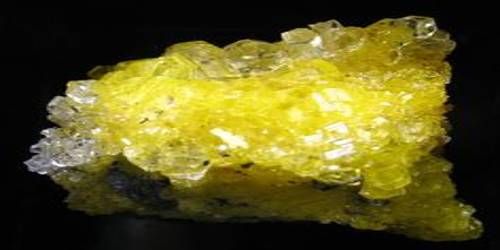Definition –
Trap Rock, also known as either trapp or trap, is a name used in the construction industry for any dark-colored igneous rock that is used to produce crushed stone. Basalt, gabbro, diabase, and peridotite are the most common rock types referred to as trap rock.
Trap Rock is a form of igneous rock that tends to form polygonal vertical fractures, most typically hexagonal, but also four to eight sided. The fracture pattern forms when magma of suitable chemical composition (typically basaltic) intrudes as a sill or extrudes as a thick lava flow, and slowly cools.
Because of the regular vertical fracture planes plus frequent horizontal fractures, trap rock tends to appear in orderly structures resembling piles of blocks, sometimes reminiscent of stairs and inspiring the term “trap”, which derives from a Scandinavian word meaning “steps” or “stairs”.
Trapp (trap) is also used to refer to flood (plateau) basalts, e.g. the Deccan Traps and Siberian Traps. The slow cooling of magma either as a sill or as a thick lava flow sometimes creates systematic vertical fractures within the resulting layer of trap rock. These fractures often form rock columns that are typically hexagonal, but also four- to eight-sided.
Production and Uses of Trap Rock –
Trap Rock is only produced in the United States in those small areas where suitable dark-colored igneous rocks are present at the surface. Ten states account for approximately 85% of the United States trap rock production. These are shown in the pie diagram on this page.
Trap Rock in Connecticut, Massachusetts, New Jersey, North Carolina, Pennsylvania, and Virginia is mostly produced from Triassic Basin flood basalts.
About 50% of the crushed stone produced in Washington and Oregon is trap rock from the Columbia River basalts. About 60% of the crushed stone used in New Jersey is trap rock from the Palisades Sill. Nearly 90% of the crushed stone used in Hawaii is trap rock because the entire island chain is underlain by basalt flows.
Trap Rock, i.e. basalt or diabase, has a variety of uses. A major use for basalt is crushed rock for road and housing construction in concrete, macadam, and paving stones. Because of its insensitivity to chemical influences, resistance to mechanical stress, high dry relative density, frost resistance, and sea water resistance, trap rock is used as ballast for railroad track bed and hydraulic engineering rock (riprap) in coast and bank protection for paving embankments. It is also used for the production of cast rock that is used in corrosion and abrasion protection, as for sewage pipes and acid-resistant rocks.
Trap Rock is recognized as a crushed stone commodity in the Minerals Yearbook published by the United States Geological Survey. During calendar year 2014, about 7% of the crushed stone produced in the United States was trap rock. That is a total of about 88 million tons of trap rock. The pie chart on this page shows which states were important producers of trap rock in 2012.
Other uses of trap rock include gardening and landscaping, for the production of millstones, for the production of mineral fibres (basalt wool), as a flux in ceramic masses and glazes, for the production of glass ceramics, crushed as a filter aggregate (air filtration of poison gas in ABC bunkers), as filter bed material water treatment facilities, and ground as a soil improvement product. It has been used to construct buildings and churches: Trinity Church on the Green with trap rock quarried from Eli Whitney’s quarry, is a particularly colorful example of a red-orange-brown-colored, natural-faced trap rock. It was also used for foundations and railroad beds in the New Haven area.
Trap Rock can substitute for limestone as a road base material, as a concrete aggregate, and as an asphalt aggregate. It is superior to limestone when it is used in soils or water where acid resistance is important. Well-known examples of outcropping trap rock include both intrusive sills and extrusive lava flows.
They include the Palisades Sill, a Triassic, 200 Ma diabase intrusion that forms the Palisades along 80 kilometers (50 mi) of the Hudson River in New York and New Jersey. Vast areas of trap rock in the form of thick lava flows and other volcanic rocks comprise the Deccan Traps of India and Siberian Traps of Russia.
Information Sources:
